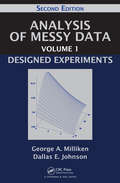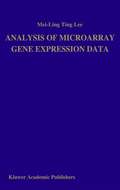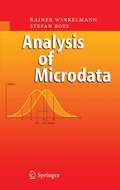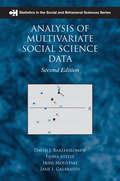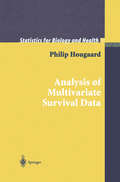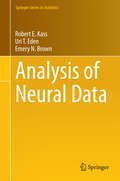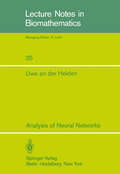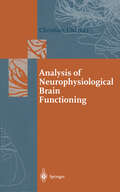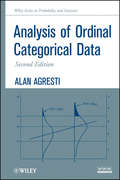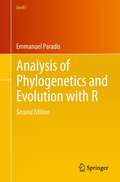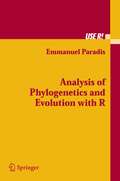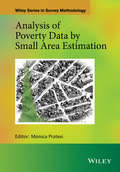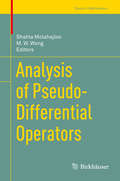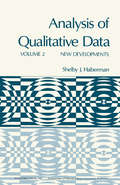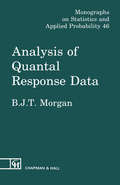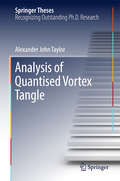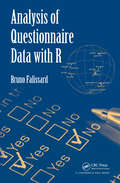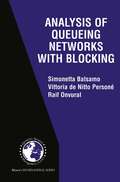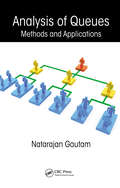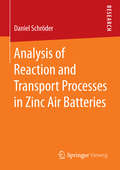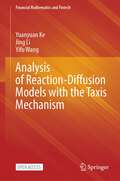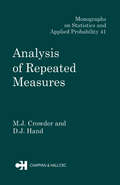- Table View
- List View
Analysis of Messy Data Volume 1: Designed Experiments, Second Edition
by George A. Milliken Dallas E. JohnsonA bestseller for nearly 25 years, Analysis of Messy Data, Volume 1: Designed Experiments helps applied statisticians and researchers analyze the kinds of data sets encountered in the real world. Written by two long-time researchers and professors, this second edition has been fully updated to reflect the many developments that have occurred since t
Analysis of Microarray Gene Expression Data (Trends In Logic Ser.)
by Mei-Ling Ting LeeAfter genomic sequencing, microarray technology has emerged as a widely used platform for genomic studies in the life sciences. Microarray technology provides a systematic way to survey DNA and RNA variation. With the abundance of data produced from microarray studies, however, the ultimate impact of the studies on biology will depend heavily on data mining and statistical analysis. The contribution of this book is to provide readers with an integrated presentation of various topics on analyzing microarray data.
Analysis of Microdata
by Rainer Winkelmann Stefan BoesThe availability of microdata has increased rapidly over the last decades, and standard statistical and econometric software packages for data analysis include ever more sophisticated modeling options. The goal of this book is to familiarize readers with a wide range of commonly used models, and thereby to enable them to become critical consumers of current empirical research, and to conduct their own empirical analyses. The focus of the book is on regression-type models in the context of large cross-section samples. In microdata applications, dependent variables often are qualitative and discrete, while in other cases, the sample is not randomly drawn from the population of interest and the dependent variable is censored or truncated. Hence, models and methods are required that go beyond the standard linear regression model and ordinary least squares. Maximum li- lihood estimation of conditional probability models and marginal probability e?ects are introduced here as the unifying principle for modeling, estimating and interpreting microdata relationships. We consider the limitation to m- imum likelihood sensible, from a pedagogical point of view if the book is to be used in a semester-long advanced undergraduate or graduate course, and from a practical point of view because maximum likelihood estimation is used in the overwhelming majority of current microdata research. In order to introduce and explain the models and methods, we refer to a number of illustrative applications. The main examples include the deter- nants of individual fertility, the intergenerational transmission of secondary schoolchoices,andthewageelasticityoffemalelaborsupply.
Analysis of Multivariate Social Science Data (Chapman And Hall/crc Statistics In The Social And Behavioral Sciences Ser.)
by David J. Bartholomew Fiona Steele Jane Galbraith Irini MoustakiDrawing on the authors' varied experiences working and teaching in the field, Analysis of Multivariate Social Science Data, Second Editionenables a basic understanding of how to use key multivariate methods in the social sciences. With updates in every chapter, this edition expands its topics to include regression analysis, con
Analysis of Multivariate Survival Data (Statistics for Biology and Health)
by Philip HougaardSurvival data or more general time-to-event data occur in many areas, including medicine, biology, engineering, economics, and demography, but previously standard methods have requested that all time variables are univariate and independent. This book extends the field by allowing for multivariate times. As the field is rather new, the concepts and the possible types of data are described in detail. Four different approaches to the analysis of such data are presented from an applied point of view.
Analysis of Neural Data (Springer Series in Statistics)
by Robert E. Kass Uri T. Eden Emery N. BrownContinual improvements in data collection and processing have had a huge impact on brain research, producing data sets that are often large and complicated. By emphasizing a few fundamental principles, and a handful of ubiquitous techniques, Analysis of Neural Data provides a unified treatment of analytical methods that have become essential for contemporary researchers. Throughout the book ideas are illustrated with more than 100 examples drawn from the literature, ranging from electrophysiology, to neuroimaging, to behavior. By demonstrating the commonality among various statistical approaches the authors provide the crucial tools for gaining knowledge from diverse types of data. Aimed at experimentalists with only high-school level mathematics, as well as computationally-oriented neuroscientists who have limited familiarity with statistics, Analysis of Neural Data serves as both a self-contained introduction and a reference work.
Analysis of Neural Networks (Lecture Notes in Biomathematics #35)
by U. an HeidenThe purpose of this work is a unified and general treatment of activity in neural networks from a mathematical pOint of view. Possible applications of the theory presented are indica ted throughout the text. However, they are not explored in de tail for two reasons : first, the universal character of n- ral activity in nearly all animals requires some type of a general approach~ secondly, the mathematical perspicuity would suffer if too many experimental details and empirical peculiarities were interspersed among the mathematical investigation. A guide to many applications is supplied by the references concerning a variety of specific issues. Of course the theory does not aim at covering all individual problems. Moreover there are other approaches to neural network theory (see e.g. Poggio-Torre, 1978) based on the different lev els at which the nervous system may be viewed. The theory is a deterministic one reflecting the average be havior of neurons or neuron pools. In this respect the essay is written in the spirit of the work of Cowan, Feldman, and Wilson (see sect. 2.2). The networks are described by systems of nonlinear integral equations. Therefore the paper can also be read as a course in nonlinear system theory. The interpretation of the elements as neurons is not a necessary one. However, for vividness the mathematical results are often expressed in neurophysiological terms, such as excitation, inhibition, membrane potentials, and impulse frequencies. The nonlinearities are essential constituents of the theory.
Analysis of Neurophysiological Brain Functioning (Springer Series in Synergetics)
by Christian UhlThe analysis of neurophysiological brain function is a highly interdisciplinary field of research. In addition to the traditional areas of psychology and neurobiology, various other scientific disciplines, such as physics, mathematics, computer science, and engineering, are involved. The book reviews a wide spectrum of model-based analyses of neurophysiological brain function. In the first part, physical and physiological models and synergetic concepts are presented. The second part focuses on analysis methods and their applications to EEG/MEG data sets. It reviews methods of source localization, the investigation of synchronization processes, and spatio-temporal modeling based on dynamical systems theory. The book includes contributions by well-known scientists such as Hermann Haken, Scott Kelso and Paul Nunez, among others. It is written for students and scientists from all the above-mentioned fields.
Analysis of Ordinal Categorical Data (Wiley Series in Probability and Statistics #656)
by Alan AgrestiStatistical science’s first coordinated manual of methods for analyzing ordered categorical data, now fully revised and updated, continues to present applications and case studies in fields as diverse as sociology, public health, ecology, marketing, and pharmacy. Analysis of Ordinal Categorical Data, Second Edition provides an introduction to basic descriptive and inferential methods for categorical data, giving thorough coverage of new developments and recent methods. Special emphasis is placed on interpretation and application of methods including an integrated comparison of the available strategies for analyzing ordinal data. Practitioners of statistics in government, industry (particularly pharmaceutical), and academia will want this new edition.
Analysis of Ordinal Categorical Data (Wiley Series in Probability and Statistics #656)
by Alan AgrestiStatistical science’s first coordinated manual of methods for analyzing ordered categorical data, now fully revised and updated, continues to present applications and case studies in fields as diverse as sociology, public health, ecology, marketing, and pharmacy. Analysis of Ordinal Categorical Data, Second Edition provides an introduction to basic descriptive and inferential methods for categorical data, giving thorough coverage of new developments and recent methods. Special emphasis is placed on interpretation and application of methods including an integrated comparison of the available strategies for analyzing ordinal data. Practitioners of statistics in government, industry (particularly pharmaceutical), and academia will want this new edition.
Analysis of Phylogenetics and Evolution with R (Use R!)
by Emmanuel ParadisThe increasing availability of molecular and genetic databases coupled with the growing power of computers gives biologists opportunities to address new issues, such as the patterns of molecular evolution, and re-assess old ones, such as the role of adaptation in species diversification.In the second edition, the book continues to integrate a wide variety of data analysis methods into a single and flexible interface: the R language. This open source language is available for a wide range of computer systems and has been adopted as a computational environment by many authors of statistical software. Adopting R as a main tool for phylogenetic analyses will ease the workflow in biologists' data analyses, ensure greater scientific repeatability, and enhance the exchange of ideas and methodological developments. The second edition is completed updated, covering the full gamut of R packages for this area that have been introduced to the market since its previous publication five years ago. There is also a new chapter on the simulation of evolutionary data. Graduate students and researchers in evolutionary biology can use this book as a reference for data analyses, whereas researchers in bioinformatics interested in evolutionary analyses will learn how to implement these methods in R. The book starts with a presentation of different R packages and gives a short introduction to R for phylogeneticists unfamiliar with this language. The basic phylogenetic topics are covered: manipulation of phylogenetic data, phylogeny estimation, tree drawing, phylogenetic comparative methods, and estimation of ancestral characters. The chapter on tree drawing uses R's powerful graphical environment. A section deals with the analysis of diversification with phylogenies, one of the author's favorite research topics. The last chapter is devoted to the development of phylogenetic methods with R and interfaces with other languages (C and C++). Some exercises conclude these chapters.
Analysis of Phylogenetics and Evolution with R (Use R!)
by Emmanuel ParadisThis book integrates a wide variety of data analysis methods into a single and flexible interface: the R language. The book starts with a presentation of different R packages and gives a short introduction to R for phylogeneticists unfamiliar with this language. The basic phylogenetic topics are covered. The chapter on tree drawing uses R's powerful graphical environment. A section deals with the analysis of diversification with phylogenies, one of the author's favorite research topics. The last chapter is devoted to the development of phylogenetic methods with R and interfaces with other languages (C and C++). Some exercises conclude these chapters.
Analysis of Poverty Data by Small Area Estimation (Wiley Series in Survey Methodology)
by Monica PratesiA comprehensive guide to implementing SAE methods for poverty studies and poverty mapping There is an increasingly urgent demand for poverty and living conditions data, in relation to local areas and/or subpopulations. Policy makers and stakeholders need indicators and maps of poverty and living conditions in order to formulate and implement policies, (re)distribute resources, and measure the effect of local policy actions. Small Area Estimation (SAE) plays a crucial role in producing statistically sound estimates for poverty mapping. This book offers a comprehensive source of information regarding the use of SAE methods adapted to these distinctive features of poverty data derived from surveys and administrative archives. The book covers the definition of poverty indicators, data collection and integration methods, the impact of sampling design, weighting and variance estimation, the issue of SAE modelling and robustness, the spatio-temporal modelling of poverty, and the SAE of the distribution function of income and inequalities. Examples of data analyses and applications are provided, and the book is supported by a website describing scripts written in SAS or R software, which accompany the majority of the presented methods. Key features: Presents a comprehensive review of SAE methods for poverty mapping Demonstrates the applications of SAE methods using real-life case studies Offers guidance on the use of routines and choice of websites from which to download them Analysis of Poverty Data by Small Area Estimation offers an introduction to advanced techniques from both a practical and a methodological perspective, and will prove an invaluable resource for researchers actively engaged in organizing, managing and conducting studies on poverty.
Analysis of Poverty Data by Small Area Estimation (Wiley Series in Survey Methodology)
by Monica PratesiA comprehensive guide to implementing SAE methods for poverty studies and poverty mapping There is an increasingly urgent demand for poverty and living conditions data, in relation to local areas and/or subpopulations. Policy makers and stakeholders need indicators and maps of poverty and living conditions in order to formulate and implement policies, (re)distribute resources, and measure the effect of local policy actions. Small Area Estimation (SAE) plays a crucial role in producing statistically sound estimates for poverty mapping. This book offers a comprehensive source of information regarding the use of SAE methods adapted to these distinctive features of poverty data derived from surveys and administrative archives. The book covers the definition of poverty indicators, data collection and integration methods, the impact of sampling design, weighting and variance estimation, the issue of SAE modelling and robustness, the spatio-temporal modelling of poverty, and the SAE of the distribution function of income and inequalities. Examples of data analyses and applications are provided, and the book is supported by a website describing scripts written in SAS or R software, which accompany the majority of the presented methods. Key features: Presents a comprehensive review of SAE methods for poverty mapping Demonstrates the applications of SAE methods using real-life case studies Offers guidance on the use of routines and choice of websites from which to download them Analysis of Poverty Data by Small Area Estimation offers an introduction to advanced techniques from both a practical and a methodological perspective, and will prove an invaluable resource for researchers actively engaged in organizing, managing and conducting studies on poverty.
Analysis of Pseudo-Differential Operators (Trends in Mathematics)
by M. W. Wong Shahla MolahajlooThis volume, like its predecessors, is based on the special session on pseudo-differential operators, one of the many special sessions at the 11th ISAAC Congress, held at Linnaeus University in Sweden on August 14-18, 2017. It includes research papers presented at the session and invited papers by experts in fields that involve pseudo-differential operators.The first four chapters focus on the functional analysis of pseudo-differential operators on a spectrum of settings from Z to Rn to compact groups. Chapters 5 and 6 discuss operators on Lie groups and manifolds with edge, while the following two chapters cover topics related to probabilities. The final chapters then address topics in differential equations.
Analysis of Quantal Response Data
by Byron J.T. MorganThis book takes the standard methods as the starting point, and then describes a wide range of relatively new approaches and procedures designed to deal with more complicated data and experiments - including much recent research in the area. Throughout mention is given to the computing requirements - facilities available in large computing packages like BMDP, SAS and SPSS are also described.
Analysis of Quantal Response Data
by Byron J.T. MorganThis book takes the standard methods as the starting point, and then describes a wide range of relatively new approaches and procedures designed to deal with more complicated data and experiments - including much recent research in the area. Throughout mention is given to the computing requirements - facilities available in large computing packages like BMDP, SAS and SPSS are also described.
Analysis of Quantised Vortex Tangle (Springer Theses)
by Alexander John TaylorIn this thesis, the author develops numerical techniques for tracking and characterising the convoluted nodal lines in three-dimensional space, analysing their geometry on the small scale, as well as their global fractality and topological complexity---including knotting---on the large scale. The work is highly visual, and illustrated with many beautiful diagrams revealing this unanticipated aspect of the physics of waves. Linear superpositions of waves create interference patterns, which means in some places they strengthen one another, while in others they completely cancel each other out. This latter phenomenon occurs on 'vortex lines' in three dimensions. In general wave superpositions modelling e.g. chaotic cavity modes, these vortex lines form dense tangles that have never been visualised on the large scale before, and cannot be analysed mathematically by any known techniques.
Analysis of Questionnaire Data with R
by Bruno FalissardWhile theoretical statistics relies primarily on mathematics and hypothetical situations, statistical practice is a translation of a question formulated by a researcher into a series of variables linked by a statistical tool. As with written material, there are almost always differences between the meaning of the original text and translated text.
Analysis of Queueing Networks with Blocking (International Series in Operations Research & Management Science #31)
by Simonetta Balsamo Vittoria de Nitto Persone Raif OnvuralQueueing network models have been widely applied as a powerful tool for modelling, performance evaluation, and prediction of discrete flow systems, such as computer systems, communication networks, production lines, and manufacturing systems. Queueing network models with finite capacity queues and blocking have been introduced and applied as even more realistic models of systems with finite capacity resources and with population constraints. In recent years, research in this field has grown rapidly. Analysis of Queueing Networks with Blocking introduces queueing network models with finite capacity and various types of blocking mechanisms. It gives a comprehensive definition of the analytical model underlying these blocking queueing networks. It surveys exact and approximate analytical solution methods and algorithms and their relevant properties. It also presents various application examples of queueing networks to model computer systems and communication networks. This book is organized in three parts. Part I introduces queueing networks with blocking and various application examples. Part II deals with exact and approximate analysis of queueing networks with blocking and the condition under which the various techniques can be applied. Part III presents a review of various properties of networks with blocking, describing several equivalence properties both between networks with and without blocking and between different blocking types. Approximate solution methods for the buffer allocation problem are presented.
Analysis of Queues (Operations Research Ser.)
by Natarajan GautamWritten with students and professors in mind, Analysis of Queues: Methods and Applications combines coverage of classical queueing theory with recent advances in studying stochastic networks. Exploring a broad range of applications, the book contains plenty of solved problems, exercises, case studies, paradoxes, and numerical examples.In addition t
Analysis of Reaction and Transport Processes in Zinc Air Batteries
by Daniel SchröderThis book contains a novel combination of experimental and model-based investigations, elucidating the complex processes inside zinc air batteries. The work presented helps to answer which battery composition and which air-composition should be adjusted to maintain stable and efficient charge/discharge cycling. In detail, electrochemical investigations and X-ray transmission tomography are applied on button cell zinc air batteries and in-house set-ups. Moreover, model-based investigations of the battery anode and the impact of relative humidity, active operation, carbon dioxide and oxygen on zinc air battery operation are presented. The techniques used in this work complement each other well and yield an unprecedented understanding of zinc air batteries. The methods applied are adaptable and can potentially be applied to gain further understanding of other metal air batteries.
Analysis of Reaction-Diffusion Models with the Taxis Mechanism (Financial Mathematics and Fintech)
by Yuanyuan Ke Jing Li Yifu WangThis open access book deals with a rich variety of taxis-type cross-diffusive equations. Particularly, it intends to show the key role played by quasi-energy inequality in the derivation of some necessary a priori estimates. This book addresses applied mathematics and all researchers interested in mathematical development of reaction-diffusion theory and its application and can be a basis for a graduate course in applied mathematics.
Analysis of Repeated Measures (Chapman And Hall/crc Monographs On Statistics And Applied Probability Ser.)
by Martin J. Crowder David J. HandRepeated measures data arise when the same characteristic is measured on each case or subject at several times or under several conditions. There is a multitude of techniques available for analysing such data and in the past this has led to some confusion. This book describes the whole spectrum of approaches, beginning with very simple and crude methods, working through intermediate techniques commonly used by consultant statisticians, and concluding with more recent and advanced methods. Those covered include multiple testing, response feature analysis, univariate analysis of variance approaches, multivariate analysis of variance approaches, regression models, two-stage line models, approaches to categorical data and techniques for analysing crossover designs. The theory is illustrated with examples, using real data brought to the authors during their work as statistical consultants.
